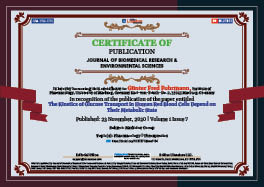Gunter Fred Fuhrmann*
Volume1-Issue7
Dates: Received: 2020-11-13 | Accepted: 2020-11-21 | Published: 2020-11-23
Pages: 334-342
Abstract
This article about freshly drawn human red blood cells offers new insights in regulation of glucose transport. Transport of glucose in Glut1 red blood cells is highly asymmetric and depend on metabolic energy, most probably ATP. The changes in “Km†for efflux and Vm obtained by ATP depletion of the cells are completely restored by incubation with adenosine, a substrate for ATP generation.
The glucose efflux in red cells is much higher than influx. The high amounts of the red cells in the blood (About 45%) provide by their efficient efflux system of more than 1000 mmol glucose/L cells/ min. support of glucose toward the peripherical cells as well as supply with oxygen.
Wilbrandt’s general rate equation including osmometer behavior of the red blood cells and the solvation of the transport resistance with the individual parameters, including the turnover of the unloaded carrier is detailed mathematically explained. It is to memorize Walther Wilbrandt and a history of his contribution to the glucose transport in human red cells.
The integrated rate equation describes perfectly the data obtained by right-angular light-scattering. Wilbrandt’s transport scheme can be used to calculate the turnover of the unloaded carrier. At 20°C a turnover of about 1000 molecules per sec. has been calculated, which might be interpreted as the oscillations of the empty carrier.
FullText HTML
FullText PDF
DOI: 10.37871/jbres1164
Certificate of Publication

Copyright
© 2020 Fuhrmann GF. Distributed under Creative Commons CC-BY 4.0
How to cite this article
Fuhrmann GF. The Kinetics of Glucose Transport in Human Red Blood Cells Depend on Their Metabolic State. J Biomed Res Environ Sci. 2020 Nov 23; 1(7): 334-342. doi: 10.37871/jbres1164, Article ID: jbres1164
Subject area(s)
University/Institute
References
- Fuhrmann GF, Liggenstorfer P and Wilbrandt W, Änderungen des Glukosetransports frischer menschlicher Erythrozyten bei längerer Inkubation, Experientia. 1971;2:1428-1430. https://bit.ly/3kMpGgZ
- Weed RI. ATP Dependence of Red Blood Cell Membrane Physical Properties: In Metabolism and Membrane Permeability of Erythrocytes and Thrombocytes, 1st International Symposium, Vienna. 1968;446-452.
- Fuhrmann GF. Transport studies in red blood cells by measuring light scattering. Methods Enzymol. 1989;173:263-80. doi: 10.1016/s0076-6879(89)73017-2. PMID: 2779428.
- Swietach P, Tiffert T, Mauritz JM, Seear R, Esposito A, Kaminski CF, Lew VL, Vaughan-Jones RD. Hydrogen ion dynamics in human red blood cells. J Physiol. 2010 Dec 15;588(Pt 24):4995-5014. doi: 10.1113/jphysiol.2010.197392. Epub 2010 Oct 20. PMID: 20962000; PMCID: PMC3036193.
- Wilbrandt W. Carrier Diffusion: Biomembranes, passive permeability of cell membranes. (Ed. F. Kreuzer and J.F.G. Slegers) 1972;3:79-99. https://bit.ly/2KqdFl3
- Lieb WR, Stein WD. Testing and characterizing the simple carrier. Biochim Biophys Acta. 1974 Dec 10;373(2):178-96. doi: 10.1016/0005-2736(74)90144-8. PMID: 4429733.
- Fuhrmann GF. Asymmetrical Properties of Glucose Transport in Human Erythrocytes: In Erythrocytes Thrombocytes Leukocytes (Ed. Gerlach E, Moser K, Deutsch E, Wilmanns W) IInd Inernational Symposium. Vienna. 1973;102-105.
- Mueckler M, Caruso C, Baldwin SA, Panico M, Blench I, Morris HR, Allard WJ, Lienhard GE, Lodish HF. Sequence and structure of a human glucose transporter. Science. 1985 Sep 6;229(4717):941-5. doi: 10.1126/science.3839598. PMID: 3839598.
- Galochkina T, Ng Fuk Chong M, Challali L, Abbar S, Etchebest C. New insights into GluT1 mechanics during glucose transfer. Sci Rep. 2019 Jan 30;9(1):998. doi: 10.1038/s41598-018-37367-z. PMID: 30700737; PMCID: PMC6353926.
- Deziel MR, Rothstein A. Proteolytic cleavages of cytochalasin B binding components of band 4.5 proteins of the human red blood cell membrane. Biochim Biophys Acta. 1984 Sep 19;776(1):10-20. doi: 10.1016/0005-2736(84)90245-1. PMID: 6541055.
- Stein WD. Channels, Carriers, and Pumps. Academic Press. 1990;140. https://bit.ly/2KeTNB2






























































